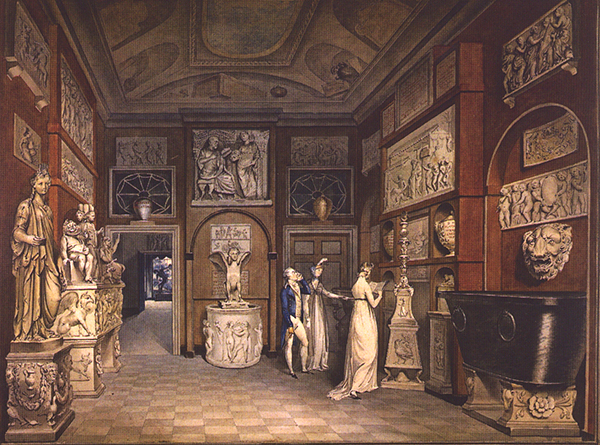
Mr. Charles Townley
Of Park-street, is universally admitted to have the finest collection of antique statues, busts, &c. in the world. They have been collected with the utmost taste and judgment, and may be seen by previously applying to Mr. Townley's to know the proper hour for admission.
Published two years before Townley's death, this excerpt from a guide to London informs the public of his collection. Townley also commissioned William Chambers to portray a visual record of the sculptures, which he did in two watercolors painted in 1794. Here in the dining room, a young woman sketches while seated at the base of the Discobolus, the red columns (painted to imitate porphyry) and blue walls deliberately offsetting the white marble of the sculptures.

Down the hallway was the entrance hall, where a visitor reads a catalog prepared by Townley, one of several that he wrote about the pieces in his collection, their subject and where they had been found. If more information were needed, he often would enter into the conversation himself, offering a short commentary upon the piece in question. Prominently displayed in the middle of the room, the Townley Sphinx sits on the wellhead that Zoffany used for the Venus in his conversation piece. Barely visible at the end of the hallway is the Discobolus, positioned in front of a window facing St. James Park. All of these sculptures were on the ground floor of the London townhouse and most remained there, rather than being installed upstairs in the first-floor library, as they were imagined by Zoffany for his painting. Indeed, John Smith, another artist employed to make drawings for Townley's portfolio, remembered when he was there as a boy that the picture was "not strictly correct as to its contents, since all the best of the marbles displayed in various parts of the house were brought into the painting by the artist, who made it up into a picturesque composition according to his own taste."
References: The Picture of London, for 1803 (1803) by John Feltham; Classical Sculpture and the Culture of Collecting in Britain Since 1760 (2009) by Viccy Coltman; Nollekens and His Times (2nd ed., 1829) by John Thomas Smith. The watercolors are in the collection of the British Museum.